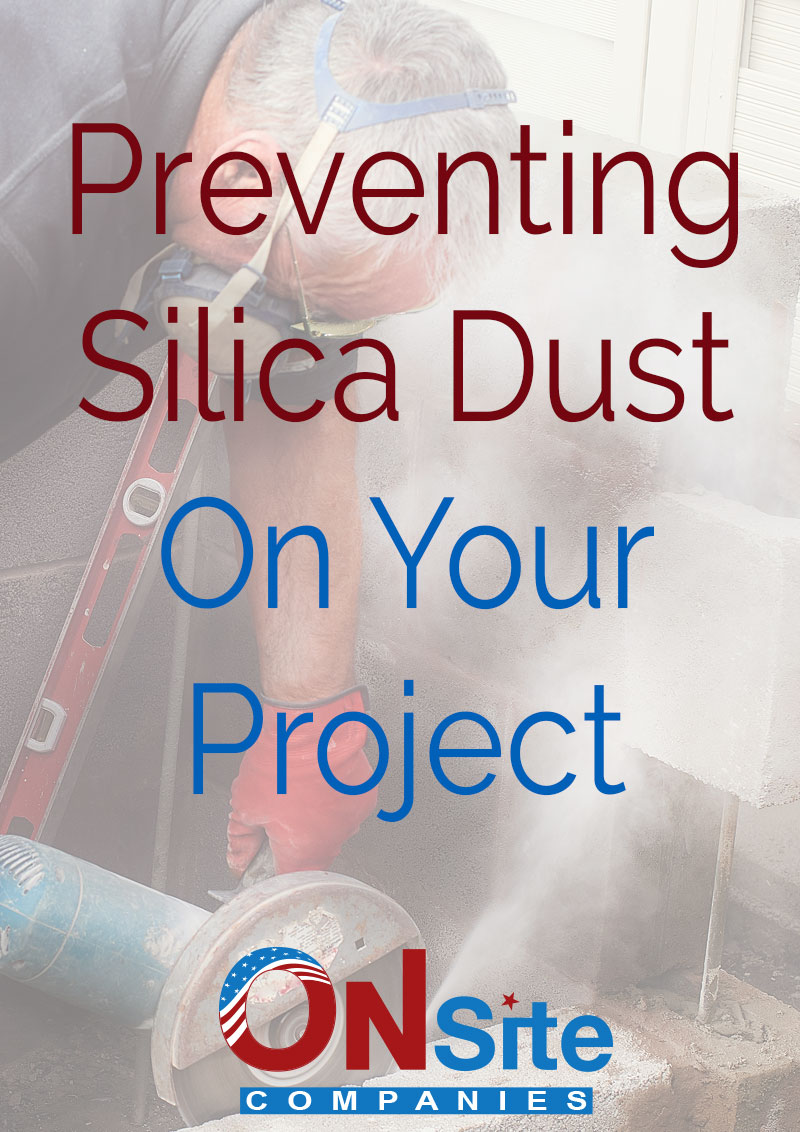Everyone knows there are a lot of different safety hazards on a construction project. There are the obvious dangers with large machinery, sharp tools, and hazardous materials. But, have you ever stopped to consider the dust generated from the work? It’s true, silica dust can be a hazard. Don’t worry, though, we have the information you need to make sure you’re not just OSHA compliant but keeping your crew healthy.

What is silica dust and silicosis?
Silica is one of the most common minerals and occurs in many building materials including, but not limited to, sand, granite, masonry, and concrete. Dust is created by blasting, cutting, chipping, drilling, or grinding materials that contain silica. Silica dust is a very fine dust with particles invisible to the human eye. These dust particles are at least 100 times smaller than a grain of typical sand.
When ingested or inhaled, silica dust can lead to a variety of lung diseases including lung cancer. One of the most common lung diseases caused by silica dust is silicosis. Silicosis is the scarring of lung tissue over time due to exposure to silica dust. Silicosis harms the ability to breathe and causes cough, weight loss, tiredness, and chest pains.
There are three types of silicosis; acute, chronic, and accelerated silicosis. Acute silicosis usually occurs within a few weeks of exposure to silica dust. Chronic silicosis appears 10 to 30 years after exposure, and accelerated silicosis will occur within 10 years of high-level exposure to silica dust with symptoms occurring quickly.
There is no one specific treatment for silicosis. Cough medicine, bronchodilators, and oxygen can help treat symptoms of silicosis. Antibiotics are prescribed for respiratory infections caused by silicosis, but do not treat silicosis itself.
The best treatment for silicosis is preventative care and avoiding exposure to silica dust.
OSHA Regulations for Silica Dust
With the obvious health hazards posed by silica dust, OSHA (Occupational Safety and Health Administration) has passed a series of regulations to deal with silica dust. OSHA provides two different methods for dealing with silica dust on their website.
The first way to be OSHA compliant is by following a table in the official regulations on OSHA’s site. This table lists common equipment or tasks and then solutions for the task. Most of the solutions listed in the table come down to making sure the tool being used has a water delivery system to limit dust or include a dust collection system.
The second method OSHA provides to be compliant is by using a formula they provide to determine the amount of silica dust present and using the correct dust controls for the dust amounts. Dust control methods recommended by OSHA include respirators for workers and a time limit to dust exposure.
OSHA also requires a written exposure plan, adequate housekeeping practices, medical exams, worker training, and records of worker exposure to silica dust.
Dust Control Solutions
There are a lot of ways to deal with silica dust on your job site. Many of the saws and grinding tools used today have a moisture-based dust suppression system or a vacuum-based collection system. While these systems are good, they will never eliminate 100% of the dust.
A fantastic addition to the built-in dust solutions are portable air filters. Portable air filters have the advantage of giving you an air cleaning solution that moves with your project. They are especially effective for contractors doing remodeling or restoration work.
On Site has several varieties of portable air filters, based on the needs of your project. The majority of our portable air filters feature HEPA (high-efficiency particulate air) filters. HEPA filters are able remove 99.9% of small particles from the air. This makes these units a very effective companion to any built-in systems a tool may already have.
Even if you are working with a tool without a dust solution, HEPA air filters like the PH 1400 can dramatically improve the air quality of your project. Not only will these units filter out dangerous silica dust, but they also will help remove odors and fumes.
On Site Has Your Air Filtration Needs
When it comes to air quality, you can’t afford to cut corners. Besides the OSHA compliance needs, workers getting sick from silica dust can lead to work delays and project slow downs. Air quality impacts your bottom line.
Call On Site today at 800.210.8407 to talk to one of our air filtration experts. Our team will help you make sure you are OSHA compliant and keep your team working. You can see our entire line of portable air filters and request a custom quote now.
Don’t let silica dust hurt your business. You may not be able to see the dust particles, but you’ll be able to see the negative impact on your business if you don’t deal with it.